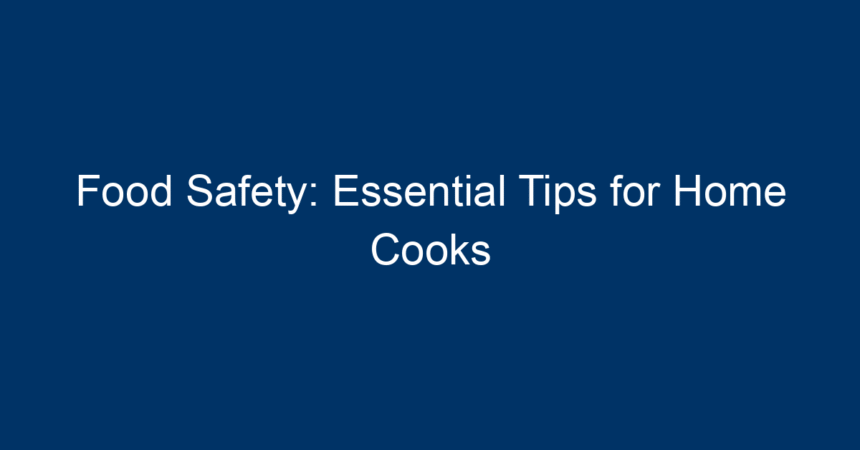Introduction
In the heart of every home, the kitchen is where delicious meals are crafted, memories are made, and nourishing ingredients come together. However, alongside the joy of cooking comes a crucial responsibility: food safety. Every year, millions suffer from foodborne illnesses, most of which can be prevented with proper safety measures. This comprehensive guide dives into essential tips for home cooks to ensure they prepare safe and delicious meals. Whether you’re a seasoned chef or a beginner in the kitchen, understanding and implementing food safety practices is essential for everyone.
Understanding Food Safety
Food safety encompasses a set of practices aimed at preventing foodborne illnesses and ensuring that food is handled properly from the farm to the table. The Centers for Disease Control and Prevention (CDC) estimates that 48 million people fall sick from foodborne illnesses each year in the U.S. alone. By embracing food safety, home cooks can protect themselves and their loved ones from harmful pathogens.
1. The Basics of Food Safety
1.1 The Importance of Cleanliness
Cleanliness is perhaps the most straightforward yet effective tip for food safety. Always wash your hands with soap and warm water before and after handling food, especially raw ingredients such as meat, poultry, and eggs. Additionally, keep your workspace, cutting boards, utensils, and cooking surfaces clean.
- Tip: Designate one cutting board for raw meats and another for vegetables to avoid cross-contamination.
1.2 Separate Raw and Cooked Foods
Cross-contamination occurs when bacteria from raw foods are transferred to cooked or ready-to-eat foods. To prevent this, always use separate utensils and plates for raw and cooked items.
- Tip: Use color-coded utensils to distinguish between raw and cooked food handling.
1.3 Proper Storage Techniques
Storing food correctly is vital to maintaining its safety and quality. Perishable foods should be kept in the refrigerator below 40°F (4°C) and should never be left out for more than two hours.
- Tip: Use the “first in, first out” method (FIFO) to manage food inventory and reduce waste.
2. Cooking Food Safely
2.1 Know Your Temperatures
Cooking food to the right temperature is crucial in killing harmful bacteria. Use a food thermometer to ensure that foods are cooked to a safe internal temperature.
-
Recommended Temperatures:
- Poultry: 165°F (75°C)
- Ground meats: 160°F (71°C)
- Fish: 145°F (63°C)
- Tip: Invest in a digital food thermometer for accurate readings.
2.2 Thawing Foods Safely
Never thaw food at room temperature, as this can provide an ideal environment for bacteria to proliferate. Instead, opt for the refrigerator, cold water, or microwave methods to thaw food safely.
- Tip: If using cold water for thawing, ensure the food is in a leak-proof package, and change the water every 30 minutes.
3. Awareness of Allergens
Food allergies are a growing concern, affecting millions of individuals. To maintain food safety for those with allergies, be aware of common allergens such as peanuts, tree nuts, gluten, dairy, and shellfish.
- Tip: Always read labels and ask guests about their allergies before preparing meals.
4. Best Practices for Fresh Produce
While fruits and vegetables are healthy additions to your meals, they can also harbor harmful bacteria. Follow these best practices to ensure their safety:
4.1 Wash Produce Thoroughly
Before consumption, wash fruits and vegetables under running water to remove dirt and bacteria. Even if you plan to peel the produce, it’s essential to wash it first.
- Tip: Consider using a vegetable brush for firm produce, such as potatoes or cucumbers.
4.2 Remove Spoiled Areas
Inspect your produce before use. If you find any spoiled areas, remove them before preparation, as they can harbor bacteria.
- Tip: Always use fresh produce within a few days of purchase to maintain quality and safety.
5. Safe Handling of Leftovers
Leftovers can be a convenient and economic aspect of cooking, but they must be handled safely to avoid foodborne illnesses.
5.1 Cool and Store Leftovers Properly
After cooking, promptly cool leftovers to below 40°F (4°C) and store them in airtight containers. Use them within three to four days.
- Tip: Label containers with dates to easily track their freshness.
5.2 Reheat Leftovers Safely
When reheating leftovers, ensure they reach an internal temperature of 165°F (75°C) to eliminate any potential bacteria.
- Tip: Stir leftovers while reheating to ensure even cooking.
6. Understanding Expiration Dates
Expiration dates are crucial indicators of food safety, but their interpretations can be confusing. Familiarize yourself with the different labels such as "use by," "sell by," and "best before" dates.
- Tip: When in doubt, assess the food’s smell, texture, and appearance before using it.
7. Maintaining a Food Safety Culture
Creating a culture of food safety in your home not only protects your family but also instills valuable lessons for children. Engage everyone in discussions about food safety practices and involve them in kitchen tasks.
- Tip: Create a food safety checklist that includes reminders about washing hands, separating raw foods, and monitoring cooking temperatures.
Conclusion
Food safety is an essential aspect of home cooking that should never be overlooked. By incorporating these essential tips into your kitchen routine, you will not only enhance your cooking experience but also safeguard the health and well-being of yourself and your loved ones. Remember, practicing food safety is not just about compliance; it’s about nurturing a culture of health and responsibility.
Taking these steps now will lead to a safer and more enjoyable cooking environment. Embrace the responsibility of being a home cook by prioritizing food safety—because everyone deserves to enjoy delicious meals without the worry of foodborne illnesses. Whether you’re whipping up a simple weeknight dinner or hosting an elaborate family gathering, a commitment to food safety will always elevate your culinary creations. Stay informed, stay safe, and most importantly, happy cooking!




